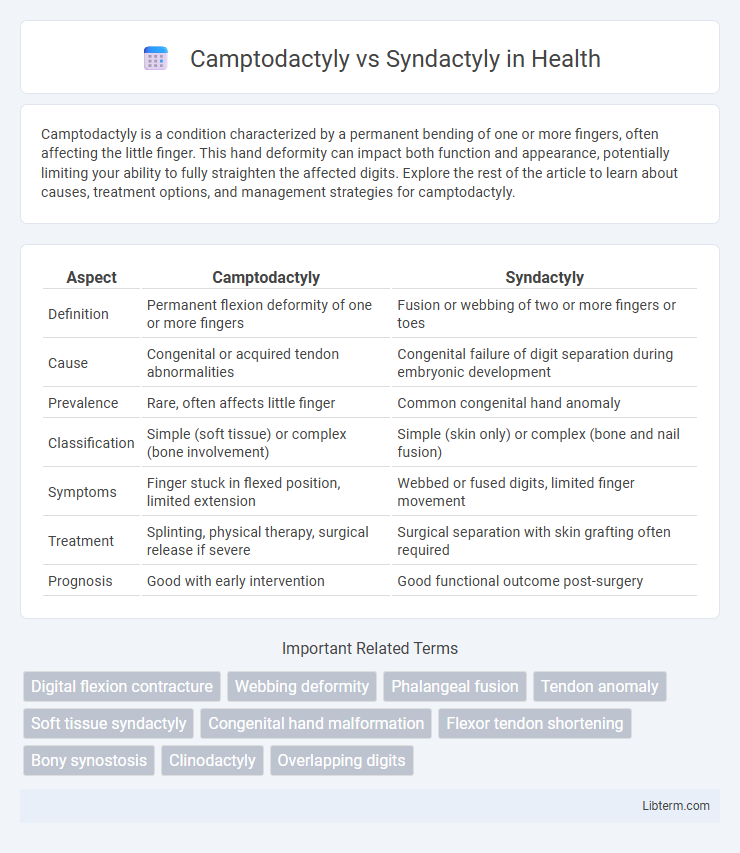Camptodactyly is a condition characterized by a permanent bending of one or more fingers, often affecting the little finger. This hand deformity can impact both function and appearance, potentially limiting your ability to fully straighten the affected digits. Explore the rest of the article to learn about causes, treatment options, and management strategies for camptodactyly.
Table of Comparison
| Aspect | Camptodactyly | Syndactyly |
|---|---|---|
| Definition | Permanent flexion deformity of one or more fingers | Fusion or webbing of two or more fingers or toes |
| Cause | Congenital or acquired tendon abnormalities | Congenital failure of digit separation during embryonic development |
| Prevalence | Rare, often affects little finger | Common congenital hand anomaly |
| Classification | Simple (soft tissue) or complex (bone involvement) | Simple (skin only) or complex (bone and nail fusion) |
| Symptoms | Finger stuck in flexed position, limited extension | Webbed or fused digits, limited finger movement |
| Treatment | Splinting, physical therapy, surgical release if severe | Surgical separation with skin grafting often required |
| Prognosis | Good with early intervention | Good functional outcome post-surgery |
Introduction to Camptodactyly and Syndactyly
Camptodactyly is a congenital condition characterized by the permanent bending of one or more fingers, most commonly affecting the little finger, due to abnormal muscle or tendon development. Syndactyly involves the fusion or webbing of two or more fingers or toes, resulting from incomplete separation during fetal development. Both conditions vary in severity and can impact hand function, often requiring medical intervention such as surgery or therapy.
Defining Camptodactyly: Key Features
Camptodactyly is a congenital condition characterized by the permanent flexion of one or more fingers, primarily affecting the proximal interphalangeal joint. Unlike syndactyly, which involves the webbing or fusion of fingers, camptodactyly results in a bent or curved finger appearance without fusion of the digits. This condition most commonly affects the fifth finger and can range from mild to severe, impacting hand function and grip strength.
Defining Syndactyly: Key Features
Syndactyly is a congenital condition characterized by the fusion of two or more fingers or toes, either involving soft tissue or bone, leading to webbed or fused digits. It often affects the second and third fingers and can vary from partial to complete fusion, impacting hand function and dexterity. Surgical intervention is commonly required to separate the digits and improve mobility and appearance.
Causes and Risk Factors of Camptodactyly
Camptodactyly primarily results from congenital abnormalities affecting the flexor tendons, skin, or muscles of the fingers, often linked to genetic mutations influencing connective tissue development. Risk factors include a family history of the condition and occasional associations with syndromes such as Jacobsen syndrome or Freeman-Sheldon syndrome. Unlike syndactyly, which arises from incomplete separation of digits during embryonic development, camptodactyly involves persistent finger flexion due to tendon or muscle contractures rather than webbing or fusion of the fingers.
Causes and Risk Factors of Syndactyly
Syndactyly is primarily caused by genetic mutations affecting the development of fingers and toes during embryonic growth, with mutations in the HOXD13 gene being a significant contributor. Environmental factors such as maternal smoking and exposure to certain drugs during pregnancy can also increase the risk of syndactyly. Family history plays a crucial role as syndactyly often follows an autosomal dominant inheritance pattern, making individuals with affected relatives more susceptible.
Clinical Presentation: How Each Condition Appears
Camptodactyly presents as a fixed flexion deformity primarily affecting the proximal interphalangeal joint, most commonly involving the little finger and resulting in difficulty fully straightening the affected digits. Syndactyly is characterized by the fusion of two or more fingers or toes, ranging from simple skin webbing to complex bony fusion, leading to reduced inter-digital separation and impaired dexterity. Clinical examination reveals camptodactyly with isolated finger contracture without webbing, whereas syndactyly shows contiguous digits with abnormal soft tissue or bone linkage.
Diagnostic Methods and Differentiation
Camptodactyly is diagnosed through physical examination showing permanent flexion deformity of the proximal interphalangeal joint, confirmed by imaging such as X-rays to rule out bone abnormalities. Syndactyly diagnosis relies on visual and tactile assessment of fused digits, with ultrasound or MRI used to evaluate soft tissue and bone fusion. Differentiation involves noting camptodactyly's isolated finger flexion versus syndactyly's characteristic webbed or connected fingers, often requiring genetic testing for syndromic cases.
Treatment Options for Camptodactyly
Treatment options for camptodactyly primarily include conservative methods such as splinting and physical therapy aimed at improving finger mobility and preventing contractures. Surgical intervention may be considered in severe cases or when conservative measures fail, involving procedures like tendon lengthening or joint capsule release to restore function. Early diagnosis and customized treatment plans are crucial for optimal outcomes in patients with camptodactyly.
Treatment Options for Syndactyly
Syndactyly treatment primarily involves surgical intervention to separate fused fingers and improve hand function, typically performed between 6 months and 2 years of age to minimize complications and promote normal growth. Skin grafts or local flaps are often necessary to cover the exposed areas after separation, ensuring optimal mobility and aesthetic outcomes. Postoperative care includes physical therapy to enhance range of motion and prevent contractures, maximizing functional recovery.
Prognosis and Long-Term Outcomes
Camptodactyly typically presents with a flexion contracture of the finger, often the little finger, which may limit finger extension but usually does not affect overall hand function or cause significant disability, with many cases manageable through physical therapy or splinting. Syndactyly involves the fusion of two or more fingers, often requiring surgical separation to improve hand function and appearance; prognosis post-surgery is generally favorable, though some stiffness or scarring may persist. Long-term outcomes for both conditions depend on severity and treatment timeliness, with early intervention in syndactyly enhancing functional recovery while camptodactyly outcomes vary based on flexibility and responsiveness to conservative management.
Camptodactyly Infographic

 libterm.com
libterm.com